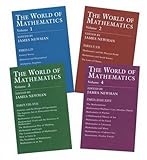For original source material (more essays than papers, but a pretty big mix of stuff), this set is fabulous: http://www.amazon.com/The-World-Mathematics-Four-Volume-Set/...
Both can be found pretty cheap used online.
IMHO, the article reflects more on the headline writer's knowledge of mathematics and its influence than on the schools for offering courses which attempt to bridge the gap between cultures. Maybe, if the author had taken a course like the ones described, the headline would have read differently.
The culture of mathematics is important to understanding the field and how to appreciate its beauty and apply it to practical problems. My love and appreciation for mathematics came, in part, from reading every word of James R. Newman's four volume World of Mathematics (Amazon: http://www.amazon.com/World-Mathematics-Four--Set/dp/0486432...) published originally in 1956. It is now published by Dover in paperback and available at O($46). It's not a book to read to learn math, but it is a book to learn mathematical thinking. And while you are in the mood, you might also look at Polya's How To Solve It (Amazon: http://www.amazon.com/s/ref=nb_sb_noss?url=search-alias%3Dst... ), another classic.


- Proofs and Refutations by Imre Lakatos (https://en.wikipedia.org/wiki/Proofs_and_Refutations) (makes you think about what a proof really is)
- The World of Mathematics: not a lot of math proper, doesn’t have much depth, but lots of examples of applied math, interwoven with mentions of the history of mathematics (https://www.amazon.com/World-Mathematics-Four-Set/dp/0486432...)